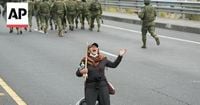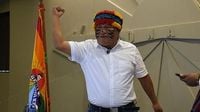Protests have erupted across Ecuador in recent weeks, as thousands of citizens—led by bus drivers and Indigenous farmers—have taken to the streets in a wave of unrest that has paralyzed parts of the country and put President Daniel Noboa’s administration under mounting pressure. The catalyst for this turbulence was a government decision on September 12, 2025, to eliminate the diesel subsidy, raising prices from $1.80 to $2.80 per gallon. For many Ecuadorians, especially those working in the agricultural, fishing, and transport sectors, this price hike has been a heavy blow—one that’s hit Indigenous communities particularly hard.
According to reports from Le Monde and the BBC, the removal of the diesel subsidy triggered immediate and widespread demonstrations. Roads have been blocked, cities disrupted, and the capital, Quito, has seen some of the most intense clashes. The Confederation of Indigenous Nationalities of Ecuador (CONAIE), the country’s largest Indigenous organization, has played a central role in organizing the protests. Since September 22, CONAIE-led groups have blocked roads in key provinces, including Pichincha, which encompasses Quito.
The response from the government has been swift and forceful. On October 9, Ecuador’s military began deploying 3,000 soldiers to Quito, aiming to restore order after weeks of mounting tension. Army officials, communicating with journalists, stated, "Military personnel, air and ground resources have begun a large deployment toward the city of Quito in order to safeguard security there." Just days earlier, the government had already sent 5,000 troops to the capital following an alarming incident: President Noboa’s motorcade was attacked by a group of about 500 protesters who pelted it with stones. According to the defense minister, this was nothing short of an "assassination attempt," with one official noting that Noboa’s car bore bullet marks. Despite the attack, the president emerged unharmed.
But the escalation has come at a cost. Human rights groups and officials report that one protester has died, around 160 people have been injured, and more than 110 have been detained since the unrest began. The violence has been especially pronounced in northern provinces like Imbabura, where Noboa had previously secured a majority in the April 2025 elections. The government and protest leaders have traded accusations, each blaming the other for the spike in violence and the lack of progress toward dialogue.
For many Ecuadorians, the elimination of the diesel subsidy is more than a policy change—it’s a matter of survival. The agricultural, fishing, and transport sectors rely heavily on affordable fuel, and many workers in these industries are Indigenous. As one bus driver told the BBC, "With diesel at this price, we can’t afford to work. Our families depend on this income." Farmers and fishermen echo these concerns, warning that higher fuel costs will drive up prices for food and transport, squeezing already tight household budgets.
The unrest isn’t just about economics, though. It’s also a struggle over political power and representation. CONAIE’s leader, Marlon Vargas, has been outspoken in his criticism of the government, warning that if necessary, his supporters would "take over" Quito. This isn’t an idle threat; past CONAIE-led protests have toppled three presidents in Ecuador’s recent history. President Noboa, however, remains defiant. "No one can come and forcibly take over the capital," he declared, pushing back against the mounting pressure from protest leaders.
As the demonstrations have continued, the government’s heavy-handed response has drawn scrutiny. Deploying thousands of troops to the capital is a dramatic step, and some observers worry it could inflame tensions rather than calm them. The memory of past confrontations between Indigenous groups and the state is still fresh in Ecuador. In previous years, similar protests have led to violence and, in some cases, to the downfall of sitting presidents. The stakes, in other words, are high for both sides.
Despite the chaos, there’s been little movement toward dialogue. Both the government and protest leaders remain entrenched, each accusing the other of fueling the violence. According to Le Monde, the government has yet to open formal talks with CONAIE or other protest organizers, leaving the situation at a dangerous impasse. Meanwhile, daily life in parts of Ecuador has ground to a halt. Transport disruptions have made it difficult for people to get to work or school, and the threat of violence hangs over many communities.
The political context is also crucial. President Noboa, who came to power with strong support in the northern provinces, now finds his mandate under threat. The very regions that helped propel him to victory in April are now at the center of the protest movement. For many voters, the diesel subsidy was a lifeline, and its removal feels like a betrayal. The government argues that eliminating the subsidy is necessary to balance the budget and attract foreign investment, but for those struggling to make ends meet, such arguments ring hollow.
International observers are watching closely. Ecuador’s political stability has long been fragile, with economic shocks and social unrest frequently leading to government crises. The current protests are a stark reminder of how quickly things can unravel. Some analysts warn that if the government doesn’t find a way to de-escalate the situation—perhaps by restoring some form of subsidy or opening talks with protest leaders—the unrest could spiral further out of control.
The images from Quito and other affected regions are striking: soldiers standing guard at intersections, buses idled on city streets, and protesters waving flags and chanting slogans. The sense of uncertainty is palpable. For many Ecuadorians, the question now is not just when the protests will end, but what kind of country will emerge from this crisis.
As of now, the path forward is anything but clear. With no dialogue underway and both sides digging in, Ecuador faces a critical test of its democracy and its ability to address the needs of its most vulnerable citizens. The coming days will be decisive—not just for President Noboa and his government, but for the future of Ecuador itself.


